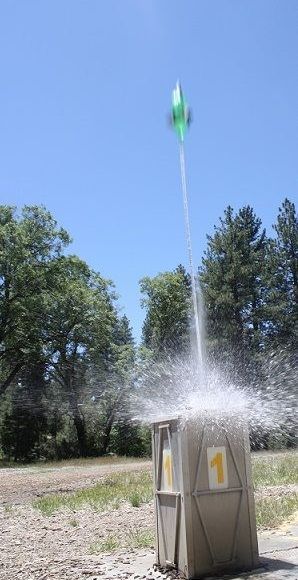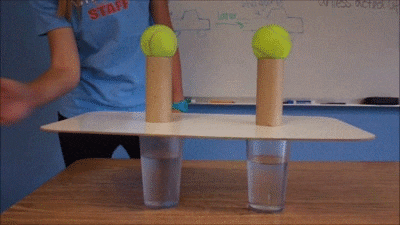
 Rockets blast off from earth with a rumble and cloud of smoke on their way through the atmosphere to the vacuum of space beyond. This is something that is accepted today, but it hasn’t always been that way. Doctor Robert Goddard is known as the father of modern rocketry, but when he first postulated the current method of rocket propulsion in space, he was ridiculed. Even the New York Times published an article on the preposterousness of his ideas. Although rockets had been around for centuries, trying to use them in space was seen as ridiculous at the time.
Rockets blast off from earth with a rumble and cloud of smoke on their way through the atmosphere to the vacuum of space beyond. This is something that is accepted today, but it hasn’t always been that way. Doctor Robert Goddard is known as the father of modern rocketry, but when he first postulated the current method of rocket propulsion in space, he was ridiculed. Even the New York Times published an article on the preposterousness of his ideas. Although rockets had been around for centuries, trying to use them in space was seen as ridiculous at the time.
The tools for understanding the basis of how a rocket works had been developed by Sir Isaac Newton hundreds of years earlier. Using Newton’s Laws of Motion, most of rocketry can be understood with relative ease.
His first law, often referred to as the law of inertia, states that an object in motion or at rest will remain in motion or at rest, respectively, unless acted upon by an outside force. This means that a rocket in space can turn its engines off and not slow down or even turn– unless an outside force, like gravity, acts on it. The bottle rockets in the video run out of fuel after a tiny fraction of a second, but they continue traveling upward until Earth’s gravity overcomes their momentum.
 This variation on the classic “pull out the tablecloth” trick is a great example of Newton’s first law. Nothing pushes or pulls the tennis balls sideways, so inertia mandates that they don’t move horizontally. For more cool inertia demonstrations, check out our blog post here.
This variation on the classic “pull out the tablecloth” trick is a great example of Newton’s first law. Nothing pushes or pulls the tennis balls sideways, so inertia mandates that they don’t move horizontally. For more cool inertia demonstrations, check out our blog post here.
Newton’s second law is most easily understood as an equation.
![]()
 The equation says that if you apply the same force to objects of two different masses, the lighter one will accelerate more than the heavier one. This shouldn’t be a surprise. If you kick a car with all your might, and then go kick a soccer ball with the same force, you will see (and feel) the difference! It’s easier to move or stop a light object than a heavy one.
The equation says that if you apply the same force to objects of two different masses, the lighter one will accelerate more than the heavier one. This shouldn’t be a surprise. If you kick a car with all your might, and then go kick a soccer ball with the same force, you will see (and feel) the difference! It’s easier to move or stop a light object than a heavy one.
The third and final law is what we like to call the law of interaction: for every action, there is an equal and opposite reaction. When a person stands, they push down on the ground, and the ground presses up equally on them. Imagine being on a frozen, icy lake, so slippery that you can’t walk. Normally, when you take a step, you push backwards against the ground, which in turn propels you forwards– an equal and opposite reaction. On an icy surface, you don’t have enough traction to push and move ahead this way. So, are you stuck? Not quite! Imagine standing on the ice and throwing a heavy rock. The rock exerts an equal and opposite force on you, pushing you in the other direction! Thinking this way makes a rocket easy to understand. Just like you can move across a slippery surface by throwing a heavy object away from you, a rocket can travel through the vacuum of space by shooting fire in the direction opposite its desired flight path.
 A rocket doesn’t have to push against the air. It just throws fire out behind it, and the equal and opposite force thrusts it forward. As you can see, the basic idea behind rocket propulsion isn’t so complex after all.
A rocket doesn’t have to push against the air. It just throws fire out behind it, and the equal and opposite force thrusts it forward. As you can see, the basic idea behind rocket propulsion isn’t so complex after all.
So, what makes rocket science difficult in practice? Well, a rocket is basically a gigantic cylinder of explosive fuel with a nozzle to direct the explosion. The whole system moves at a very high speed. Without the right knowledge to control it, that’s a recipe for disaster! A rocket is also constantly launching its fiery fuel out behind it, so its mass is always changing. This makes calculations less than straightforward. As is the case in many fields, the core concepts in rocketry are simple. Complications arise when applying these ideas in real-world situations that require a lot of precision.

Blast-Off for the first space shuttle in 1981 from Kennedy Space Center. Credit NASA
